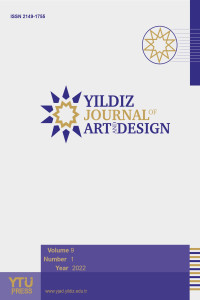" Employing Photoshop in Producing Art Works from Raw Material and Consumed Waste
The purpose of the study was to examine the effective use of Photoshop software in reproducing the visual image in the handicrafts presented at visual arts department, faculty of fine arts, Yarmouk University. Another purpose of the study was to capitalize the various uses of consumed wastes and raw materials recycling in art works innovation contributing in the promoting the notion of the diversified raw material used in plastic arts, and to how extent students of plastic art can benefit from using processed images via Photoshop software in their handiworks of art work. Finally, the study sought to improve the cultural, visual and social environment by recycling consumed wastes and raw materials. The most important results found in the study is that there is a need for encouraging students to positive innovation and creativity, to install collaboration and prosocial behaviors, and environment sustainability by disposing consumed wastes and transforming them to art works with high value
Anahtar Kelimeler:
Visual Image
___
- References Al Wadi, Ali, and Khadir, R. (2011). Marginalization in the postmodern art. Amman: Jordan, Dar Safaa, Dar Al-Sadiq. Al-Hattab, Kassem, 2010. “Aesthetics of Plastic Art in the European Renaissance and Modern and Contemporary Art Schools. Dar Alnahda Asker, N and Hassan, A. (1994). Effect of Photoshop in developing the skill of teaching aids design (publications). Al-Adab Journal. Baghdad University 96. Pp. 607-634 Davies. A. (2012). Computer-aided Drawing and Design. Springer Science & Business Media Bogousslavsky, J and Tatu, L. (2018). Neurological Disorders in Famous Artists. Karger Medical and Scientific Publishers Elena and Popkova. (2019). The 21st Century from the Positions of Modern Science: Intellectual, Digital and Innovative Aspects. Springer Nature Fadali, F, (1991). Synthesis of materials on the surface of the image in the field of photography Contemporary, Unpublished Master Thesis, Faculty of Art Education, Helwan University, Cairo. Hill, D. (2010). About Face: The Secrets of Emotionally Effective Advertising. London: Kogan Page. Crowther, P. (2018). Geneses of Postmodern Art: Technology as Iconology. Routledge Advances in Art and Visual Studies. Routledge. Madoff, S. (1997). Pop Art: A Critical History. Berkeley and Los Angeles: University of California Press,. Nasser, Zahra. (2008). Pop as an introduction to the creation of synthesis of plastic painting. Unpublished Master Thesis, College of Art Education, King Saud University, Saudi Arabia. Oechsli, Matt. (2005) The Art of Selling to the Affluent: How to Attract, Service, and Retain Wealthy Customers and Clients for Life. Hoboken, N.J.: Wiley. Smith, E. (1995) "Artistic Movements after World War II", translated in Arabic: Fakhri Khalil. Dar Almamoun Bagdad. Figure references: 1- Figure No. 1, Archery with Four Faces, 1955, Jasper Jones, available at (https://www.moma.org/collection/works/78393), accessed on 2/12/2017. 2- Figure No. 2, The Leaping Jump, Robert Ruchtberg, 1961, available at (https://www.moma.org/collection/works/81468?locale=en), accessed on 2/12/2017 3- Figures No. (3., 4, 5, 6, 7 and 8), a special photograph by the researchers
- Başlangıç: 2013
- Yayıncı: Yıldız Teknik Üniversitesi
Sayıdaki Diğer Makaleler
BİLİM KURGU FİLMLERİNDE BEDEN VE MEKÂN OKUMASI
" Employing Photoshop in Producing Art Works from Raw Material and Consumed Waste
Mowafaq ALSAGGAR, Ala'a AL THENAT
COVİD-19 SALGINININ KÜLTÜR VE SANAT ORGANİZASYONLARINA ETKİSİ
